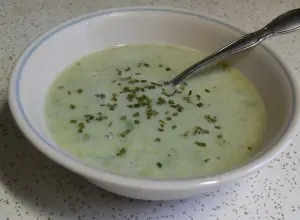Asparagus are not always the first veggies that we reach for in the grocery store, but why not? These vegetables are rich in nutrients, vitamins, and minerals–and are super delicious.
Mostly available during spring, which is called the “asparagus season”, asparagus is not only good by itself, but actually helps to enhance the flavors and appearance of any entrée with which it’s paired.
If you find some asparagus on sale in the product department (or if you’re just going to splurge and treat yourself), never pass up any chance to serve this versatile vegetable to your family.

When we get a hold of asparagus (on sale or not!), we know we have to handle it with some care before we even start cooking it. The correct washing, handling, and storing of asparagus helps prolong its shelf life, so it’s essential to learn how to best deal with this veggie, especially because asparagus is available for a limited season and it is also usually more expensive than other green foods.
Keep reading and we will share with you all the tips and tricks of how to keep asparagus fresh for extended periods. As a bonus, we also have suggestions on how you can maximize the use of asparagus!
How to Wash Asparagus
Washing asparagus before preparing and cooking it is essential. Not only do you need to clean off any dirt or pesticides (and yes, even organic vegetables need to be washed before eating), you want to make sure any tiny insects that may be hanging out in your fresh bunch of asparagus are washed away.
It’s always best to just be on the safe side and clean your asparagus before use. To do so, just follow these easy steps:
- Fill a bowl large enough to hold your asparagus with cold water.
- Remove the tight rubber band that’s keeping your asparagus in a bunch. Doing so can avoid any bruising of the vegetable.
- Soak the asparagus in the bowl or water for several minutes.
- Rinse off the stems to make sure they are free from any residue. Then, dry them using a clean kitchen towel or paper towels.
- Break off the ends by holding each end and snapping it on its breaking point.
- Separate the root end, which is the tougher part, and the flower end, which is the tender part. You can use these parts in your recipe as needed.
- For thicker asparagus, you can peel the tough coating if you wish to.
- Store the washed asparagus properly in the refrigerator or freezer.
On the other hand, you can clean your asparagus using vinegar (as you can with other fruits and vegetables). Spray the asparagus with a mixture of vinegar, water, and lemon juice. Rinse the asparagus with water, and dry it with paper towels.
How to Store Asparagus
If there is only one thing about asparagus that you absolutely should remember, it’s the fact that it survives and thrives in a damp environment. This information is essential to keep in mind, especially if you are planning to store a bunch of asparagus properly.
It’s definitely a big no-no to just keep your asparagus inside the plastic bag from the grocery store and place it inside the fridge. You will waste your asparagus this way.
We know of two good ways to ensure that you are storing asparagus properly to keep it fresh the longest: storing it properly in the fridge or freezer. To find out which way will work best for you, read on.
How to Store Asparagus in the Refrigerator

Asparagus can last up to a week if stored properly in your refrigerator. The best part is, preparing the asparagus for refrigerated storage is easy and doesn’t take much of your time. To begin, you will need to gather the following:
- Bunch of asparagus
- Jar
- Water
- Plastic bag
Directions:
- Wash asparagus and cut an inch off both ends of each spear.
- Place the asparagus spears inside the glass jar, cut ends on the bottom.
- Add about an inch of water to the jar.
- Loosely cover the tips of asparagus with a plastic bag. (This step is essential, as the vegetables need circulating air to stay fresh.)
- Store the asparagus in the fridge for up to 10 days.
- If the water becomes cloudy, change it as needed.
How to Store Asparagus in the Freezer
It may seem surprising, but yes, you can store asparagus in the freezer!
Freezing asparagus is one way to enjoy this seasonal vegetable even when it’s no longer springtime. However, you must realize that you won’t experience the same crisp and snappy stems when you freeze asparagus. The reason: ice crystals damage the succulent stems’ cell walls, making frozen asparagus lost some of its firm texture.
To store asparagus in the freezer properly, do the following:
- Prepare. Prepare your asparagus by washing, trimming, and cutting the spears.
- Blanch. Blanching is key when it comes to freezing vegetables. Boil or steam the asparagus for a short period and end the cooking process with a quick ice bath. To do this, you need to sort your asparagus according to its thickness. Small spears need 90 seconds to blanch; medium stalks, 120 seconds; and thick steams for up to 180 seconds. After blanching it, you’ll notice that your asparagus has a brighter green hue.
- Cool. After boiling, transfer the asparagus to a bowl of ice water.
- Dry thoroughly. Let the spears dry for about 10-20 minutes, patting them as dry as you can beforehand using paper towels or a clean kitchen dish cloth.
- Pack. For best results, divide your asparagus into small serving sizes, as you may not be using all of your asparagus at once, especially if you bought a lot on sale at the grocery store or in bulk from the farmer’s market. Place each serving of asparagus inside a freezer bag. Squeeze any air out of the bag and seal it tightly. Label the bag with the date of storage for reference.
- Freeze. Place the freezer bags inside the freezer.
How Long Does Asparagus Last?
The shelf life of asparagus depends both on how it is stored and whether it is raw or cooked.
When it’s stored correctly in the refrigerator, fresh asparagus expires in a week, but it lasts up to a entire year when stashed away properly in the freezer.
Cooked asparagus lasts 3 to 5 days when saved in the refrigerator, while it lasts for up to 10 to 12 months if you’re saving it correctly in the freezer.
As you can see, if you want to keep either cooked or fresh asparagus for more than a few days, freezing is your best option.
Does Asparagus Go Bad?
Yes. Like any food, asparagus will go bad eventually–but sooner if not stored properly.
The tips of the asparagus are usually the first part to show signs of rot, so you need to check only the tips when looking for evidence of spoilage. If the flowery part looks dark green (almost black) and feels even slightly mushy, the asparagus has most likely gone bad.
If this happens, cut off the tips and cook the rest of the asparagus spears as soon as possible. Otherwise, the vegetable’s stems will be affected and may begin to mold and rot as well. If your asparagus is more mushy and dark than otherwise, simply throw it away.
What Can I Do with Extra Asparagus?

Let’s be honest: we all know that asparagus is an expensive treat. If you’ve got extra, don’t waste money and good food by tossing it. Whenever you have extra asparagus on-hand, refer to these ideas about how to use it in other tasty ways.
- Egg dishes. Asparagus can be a great addition to omelets, quiches, and frittatas. It gives these dishes a texture that no other vegetable can truly provide.
- Appetizer with a dip. You can also serve your extra asparagus as an appetizer paired with a creamy dip.
- Salad add-ons. Adding some thin slices of asparagus in your salad will add more flavor and texture to your regular lunch go-to.
- Pasta. Add extra asparagus to pasta served with alfredo sauce and find out how absolutely delicious this combination is.
- Fried rice. Adding some chopped asparagus to your usual veggie fried rice will make you want more and more while adding amazing nutritional benefits to your fried rice, which is already rich in carbs.
- Soups. There’s no question as to how asparagus is one of the most amazing ingredients for a creamy soup. Cream of asparagus soup as a starter instead of cream of broccoli or cream of cauliflower is an unexpected and sophisticated little dish.
- Bruschetta. You can use your extra asparagus as another topping for this simple dish to make it even more delectable (and even healthier).
- Risotto. Asparagus adds a perfect addition to risotto. All you need to do is add the asparagus towards the end of the risotto’s cooking time to heat it up.
Conclusion
Asparagus is a unique vegetable full of vitamins and minerals.
Since asparagus is usually available only during the spring, it makes sense to learn how to prolong its shelf life and keep its freshness intact so you and your family can enjoy it long after even summer is over.
Asparagus can be stored in the refrigerator or freezer. While both methods are effective, if you want to have a year-long stock of asparagus, you’ll absolutely need to freeze it. It’s always best to be prepared for any recipe at any time!
Frequently Asked Questions
How do you know if asparagus has gone bad?
One easy way to spot if your asparagus has gone bad is by checking its tips. If the tips have turned dark green or black and is a bit slimy, or if black spots have appeared on the steams, you need to discard it right away.
However, as with other vegetables, you can cut off the parts that are going bad and use the rest of the asparagus. We all know that asparagus is pricier than other vegetables; use it before it goes bad or at least cut off bad parts and cook it before allowing it to just rot completely.
How do you keep asparagus fresh longer?
To keep asparagus fresh longer, you need to store it properly, either in the fridge or the freezer.
If you plan to store asparagus in the refrigerator, all you need is a jar, some ice water, and a plastic bag. Stored this way, your asparagus will last up to a week. On the other hand, you can store it in the freezer by blanching it and then placing servings of it in freezer bags to use later. This procedure will allow asparagus to last up to a year.
Do you need to refrigerate fresh asparagus?
Yes, you need to refrigerate asparagus if you wish to prolong its shelf life. Storing asparagus properly in the refrigerator can help asparagus last up to a week.
The reason behind this is the presence of water. Asparagus thrives in a damp environment. With an inch of water in the bottom of the jar, asparagus can be loosely covered with plastic. A reminder: i the water becomes clouded, change it as soon as possible.
Are you supposed to wash asparagus before cooking?
Yes, you need to wash and clean asparagus before cooking it. Even if it’s organically grown, your asparagus has particles of fine grit or sandy soil that need to be removed before it can be prepared and eaten. Pour ice cold water into a large bowl and soak the asparagus for a few minutes. Afterward, rinse off the asparagus and dry it gently using kitchen dishcloths or paper towels.
Can you clean asparagus with vinegar?
Yes, you can clean asparagus with vinegar. The truth is, most fruits and vegetables can be cleaned with it, too. All you need to do is make your solution composed of 1 cup vinegar, 4 cups of water, and a tablespoon of lemon juice. Transfer this mixture to a spray bottle and shake it to mix the ingredients properly. Then, simply spray your asparagus with the mixture. Let it be for at least two to five minutes, then rinse your asparagus with cold water and dry it thoroughly using paper towels or kitchen towels.
Can you get sick from eating old asparagus?
It’s not safe to eat asparagus once it has gone bad. If you notice any mold, discoloration, mushiness, or an odd smell, discard the asparagus immediately. If some parts of the stems are still okay, then you can remove the dark spots and still cook and eat it. It is not advisable to eat old asparagus, though, especially if it hasn’t been stored properly and it is already beyond its expiration date.
Additional Resources
- YouTube: Three Sautéed Asparagus Recipes
Image Credits via Flickr: michaelnpatterson; photophnatic; barnimages.com





Rhonda grew up with parents who gardened, hunted, fished, canned, and preserved food. Her mother was a professional cook and Rhonda credits her teaching everything from how to make homemade biscuits and gravy to what kind of meals to serve for different occasions. In the kitchen, Rhonda uses a mix of old-fashioned country cooking and up-to-date fads in the kitchen, often experimenting with replacing higher-calorie or fat ingredients with healthier options that still retain the delicious flavors of the originals.